Neverwinter Nights Preview
We travel to BioWare to take a look at the latest build of its ambitious RPG.
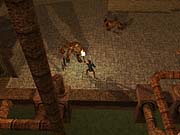
Neverwinter Nights is one of the most highly anticipated computer role-playing games to date because it stands to be one of the most impressive. We recently visited BioWare's offices in Edmonton, Alberta, to see its forthcoming online Dungeons & Dragons-based role-playing game and to give you the lowdown on how it's been coming along since we saw it last year. The good news is Neverwinter Nights still looks very exciting. The great news is it's still got plenty of potential. We've got the scoop on how its multiplayer mode and dungeon master tools are coming along and also on some of the first details about the game's single-player campaign.

"It's the largest project we've ever undertaken," admitted Trent Oster, the producer of Neverwinter Nights. BioWare's next big project has actually been in development for more than four years now--two years in full force--and it represents a culmination of many of the best ideas of BioWare's designers. Essentially, the game is designed to be the closest thing to pen-and-paper Dungeons & Dragons for the PC. It's a set of extremely robust tools, which are tied together with powerful multiplayer capabilities that will be best suited for closely knit player communities--or groups of such communities. Much like a real-life Dungeons & Dragons campaign you might play with your friends, Neverwinter Nights--which takes place in the same rich Forgotten Realms setting from the Baldur's Gate series--will allow you the same level of creative freedom and flexibility within its exciting, beautifully rendered environments. Of course, it has a number of significant differences compared with traditional D&D, not the least of which is the game's ability to save your character on remote servers, giving your character the same sense of permanence that you'd get from a more-conventional massively multiplayer game like EverQuest.
"It's the largest project [BioWare has] ever undertaken."- Trent Oster, producer of Neverwinter Nights
Beyond that, Neverwinter Nights promises to give all players access to powerful, easy-to-use tools with which they can build their very own Dungeons & Dragons scenarios and campaigns. This feature will especially appeal to those players who like the prospect of playing dungeon master in the first place. The dungeon master is the person who arbitrates real-life Dungeons & Dragons campaigns determines everything about the campaign. And this person will have equally limitless power over a game of Neverwinter Nights. But what's so great about the toolset in Neverwinter Nights, anyway? A lot of games ship with complementary campaign-editing utilities, and there's a very good chance that you haven't spent much time with any of these. But the designers at BioWare are making sure that they build enough automation and flexibility into the tools so that less technically minded players will still feel inclined to try to build their own scenarios. That's because the game itself can help take over when you're not sure of what to do or how technical to get.
We've got more details about the scenario-editing tools--but there's a lot more to Neverwinter Nights than that. For one thing, it'll be a full single-player game that's 60 to 70 hours long; even if you never touch the tools or the multiplayer mode, you'll still be in for an epic adventure. Read on to find out more about Neverwinter Nights' single-player mode and its other ambitious features.
The Plague
To put the single-player mode of Neverwinter Nights in perspective, the game's producer describes the game as having the epic scope of BioWare's own Baldur's Gate series, but with the addition of the robust dungeon master's toolset as well as an integrated online player-matching program.
3rd Edition
Initially, Neverwinter Nights will let you choose from a premade character or make one from scratch with the 3rd Edition Dungeons & Dragons rules. You can choose a starting experience level for your character, and you can use character templates to choose a more specialized variation of a Dungeons & Dragons profession without spending a lot of time crunching numbers. This is possible firstly because of 3rd Edition D&D's much more flexible character-creation system. In 2nd Edition--as seen in the Baldur's Gate series--when you choose a character class, you're pretty much stuck with it and its predetermined skill set, notwithstanding the occasional option to choose a new weapon proficiency. In 3rd Edition, you're given much more freedom as you gain expertise. For instance, a magic user by trade could train himself to wear light armor and then heavy armor--unheard of in previous versions of Dungeons & Dragons! Yet the decision to train himself to be like a warrior means that he would compromise some of his potential as a spellcaster. Another magic user of a similar level might not be able to wear full-plated armor but he could amplify his spells to cause maximum damage every time or could accelerate them to eliminate their casting time. Neverwinter Nights will let you choose from such variations in addition to the more-traditional versions of each character class.
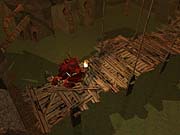
In the single-player game, you'll begin as an inexperienced character who must initially complete a training exercise put forth before him by his guild in the city of Neverwinter. An illness--in fact, it's a full-blown, deadly plague--is sweeping across Neverwinter. The city is necessarily put under quarantine. As someone who hasn't yet fallen victim to this mysterious plague, you're enlisted to try to help discover the nature of the malaise--or, better yet, a cure for it. A search for the cure will take you across more than two dozen different play scenarios--or, modules--each of which takes several hours to complete. Do the math, and you'll see that the campaign is designed to be at least 60 hours in length.
One of the most innovative features in BioWare's previous role-playing games in the Baldur's Gate series was the option to play through the campaigns either alone or with up to five other players. Neverwinter Nights also shares this great feature. Of course, the single-player game is designed such that you could finish it with just your main character--so doesn't that mean it would be too easy if you brought along some extra help? BioWare claims that this won't necessarily be the case, because the difficulty level and the experience rewards in the game will automatically shift, depending on the overall power of your party. That means if you're an army of one, you'll face suitably simpler challenges. It also means a lot more than that; find out on the next page.
Neverending Stories
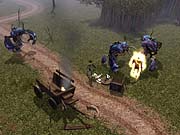
BioWare explained the automatically adjusting difficulty in Neverwinter Nights to us with this example: If you happen to stumble onto an encounter with goblins, a number of things could happen, depending on your character and his party and assuming that the game wants to play fair. If you're a low-level character, you'd probably end up fighting against a couple of greenskins, and that's it. If you're a little stronger or you have some help along for the ride--either in the form of other human players or computer-controlled hirelings--you'll have many more goblins to take care of before the battle is won. If you're much stronger, the goblins might be in cahoots with orcs and orcish shamans, who are capable of damaging you with their powerful spells, just as they can aid their many comrades with beneficial enchantments. Ultimately, if you're part of an extremely powerful war party, the encounter might even include something worse--for instance, a lich, whose centuries-old thirst for blood will probably make for a serious problem.
The Original
The game's inherent ability to determine the strength and makeup of random encounters on the fly should prove to be one of its many interesting features. Thus, no matter how powerful you are, the single-player campaign will not only provide a challenge, but it will also give a lot of replay value and flexibility to your own custom-made scenarios. For instance, if you put a lot of time into creating a great dungeon crawl for low-level characters, you might be a little disappointed that, well, you've made a dungeon crawl for low-level characters. But the adjustable random encounter table means, with a little more tweaking, that you could make your dungeon suitably challenging for all types of characters. Experience and monetary rewards can likewise be scaled for different adventurers. The scenario tools even let you translate text and dialogue into multiple languages for internationally localized versions of your adventures!
Of course, such a system assumes an inherent level of balance. That is to say, would an equivalent high-level encounter really prove more challenging than a low-level one? Or would the high-level encounter be too hard? To address this, Neverwinter Nights intends to stay very true to its roots as a Dungeons & Dragons game, and it will follow the 3rd Edition rules as strictly as possible. Since a tremendous amount of effort and experience went into designing and balancing the 3rd Edition core rules, the result should make for an inherently balanced computer game--as in the example of the armor-wearing wizard vs. the more magically proficient wizard. These options, like the variable difficulty of random encounters, have been thoroughly tested for use in Dungeons & Dragons and, as such, should translate nicely into a computer game that's so closely based on those rules.
Not every battle in Neverwinter Nights will be strictly dependent on your character. After all, how much fun could you have if you never had an opportunity to come back much later when you're much tougher, to show those goblins a real run for their money? To this end, Neverwinter Nights also features a very powerful (and easy-to-use) scripting language for creating any type of encounter in the game, either hostile or otherwise. Read on to find out about it.
Who Wrote This Damn Script?
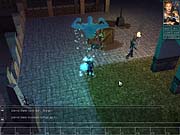
The scripting language in Neverwinter Nights lets you do whatever you want. Although the designers of Baldur's Gate used a similar language to create the memorable situations in that series, Oster notes that the scripting language in Neverwinter Nights is "very easy to use, and a lot more powerful" compared with that of Baldur's Gate. You use it in creating character personalities, special events, and so forth, and it gives you as much or as little flexibility as you feel comfortable with. Essentially, any event can be used to trigger any other event. You can use the scripting language in the game to create elaborate, interesting dialogue sequences with computer-controlled characters or you can use it to orchestrate a sinister enemy ambush.
"It's very easy to use and a lot more powerful."- Trent Oster, producer of Neverwinter Nights, comparing the scripting language of the game to that of Baldur's Gate
You can use the scripting language to create dialogue trees, as seen in games like Baldur's Gate. You can script each point in the dialogue with other events. For instance, if you were engaged in a lively debate with a rival wizard and threw him a real mind-bender, you could script that character to pace back and forth and be deep in thought. The game will feature a number of premade emotive animations, which will let you bring nonplayer characters to life, especially during key points in dialogue or in combat. So, on the other hand, once an ogre chieftain's health is depleted past 20 percent, you might script him to motion so that all his forces can fall back. These are relatively advanced examples of the scripting language in the game--if you don't specify particular conditions, then rest assured such characters will still act relatively intelligently. Again, the emphasis on Neverwinter Nights--as with its scalable random encounters--is to cater to the particular tastes of whichever player happens to be interested in the game. If you don't want to script an elaborate stage performance to be seen by a group of players, you don't have to.
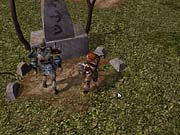
Certainly, the scripting language can seem intimidating despite its relative ease of use. Fortunately, the rest of the game will be very easy to play. Its onscreen interface is virtually nonexistent--for the most part, all you'll see are the rich, colorful graphics and a small status window that shows your character's vital stats. A circular pop-up interface (it's reminiscent of the pop-up interface in Black Isle Studios' Planescape: Torment) can be called up with a single mouse click and will give you access to each of your character's available options. From here, you'll be able to attack a character or speak with him; you'll also be able to search for traps, cast spells, and change equipment. Keyboard hotkeys will be available for each of these menu options, but the minimal, fully mouse-driven interface should be ideal for most players. Best of all, this interface will feature numerous quick-chat options for use in multiplayer scenarios. You won't need to type out "follow me" or "attack my target" or the equivalent phrase, because the game will give you easy access to these as well as other common phrases that you'll be able to use. These should be useful in a multiplayer setting, but some will actually work as orders for your computer-controlled henchmen too.
Speaking of henchmen and party members, since you're bound to get separated from your allies once in a while, how will the game let you keep track of your friends' relative locations? Actually, how will you even be able to distinguish your character from anyone else's? Even though most 3D role-playing games do give some flexibility in choosing your character's appearance, there usually isn't much variety. But, in fact, the combination of different possible player-character appearances in Neverwinter Nights ends up somewhere in the trillions. Read on to learn how that's possible and whether this and other such details can make Neverwinter Nights as great of a success as the Baldur's Gate series.
A Lot of Character
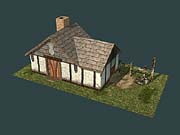
Neverwinter Nights, like Dungeons & Dragons, is a game about social interaction. And social interaction wouldn't be as interesting in the game if it didn't let you customize your appearance, let alone keep track of who your allies are and where they are. When you join a group with a character, his portrait and stats will appear next to that of your own. A persistent arrow will point in that character's relative direction, letting you know where he or she ran off to if you lose track of each other. In creating your character, of course you can choose among the numerous races available in 3rd Edition Dungeons & Dragons, from tiny gnomes on up to lumbering half orcs. These characters' relative sizes will be accurately portrayed in the game, and you'll be able to choose a unique head for your 3D character, the color of the character's hair and skin tone, and a 2D portrait. You'll also be able to make a real fashion statement with the game's massive selection of different types of armor and equipment, which are all readily recognizable on the character's 3D model.
Room to Grow
Another one of the great features in Neverwinter Nights is that it lets you create custom equipment with custom appearances. You can create your very own legendary artifacts with special properties--even with unique curses. You can adjust the color and styling of all your equipment, and it needn't even be symmetrical. For instance, you can have an enormous suit of magical, black-colored full-plate armor, half of which is torn away as a result of an ancient battle that its previous owner didn't survive. Metal objects in the game are coated in a realistic, metallic sheen--just as other graphic details are similarly authentic.
Weather patterns, day cycles and night cycles, ambient animations, and other such visual effects should give Neverwinter Nights a more convincing appearance than most computer role-playing games to date. The combat is starting to look really good, too. Characters engaged in melee won't simply stand there and hack away at each other--you'll see characters parry, dodge, and riposte; you'll see some blows glance off the opponent's armor; and you'll see characters swing their weapons in many different ways. Presumably, some of the high-level combat feats will also feature their own unique animations. This kind of visual detail will be much appreciated by Dungeons & Dragons fans--the only question is just how much BioWare can possibly cram into the game. Neverwinter Nights is still currently scheduled to ship this year--however, BioWare was quick to point out that its main commitment is to make a high-quality game and not to ship on a particular release date. And, as such, it's willing to spend as much time as necessary to hone this project to its fullest potential. The potential of a graphically rich role-playing game, which features a fully developed single-player game, an extremely powerful multiplayer mode, a great set of tools for building scenarios and campaigns, and ongoing customer and community support from its developers, is an impressive potential indeed. This preview merely accentuates some of the points that weren't yet brought to light in the many pages of preview content that GameSpot has already devoted to this ambitious game. And that's but a small-scale suggestion of the sort of scope and sheer quantity of exciting features that will be available in Neverwinter Nights once it finally ships.
Got a news tip or want to contact us directly? Email news@gamespot.com
Join the conversation